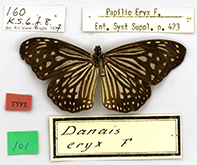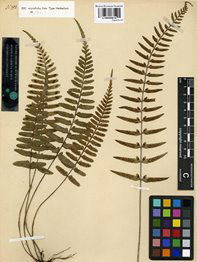About the collections
The Natural History Museum of Denmark is the main museum for natural history in Denmark and is responsible for the management of the national natural history collections, as well as associated research and public outreach.
 The many specimens in the collections derive from all over the world, and make up the main part of Danish natural history heritage. The museum’s collections are also amongst the oldest in the world, reaching back into the mid-17th century.
The many specimens in the collections derive from all over the world, and make up the main part of Danish natural history heritage. The museum’s collections are also amongst the oldest in the world, reaching back into the mid-17th century.
Many of the oldest specimens in the collections were acquired due to their beauty, peculiarity or commercial value. But by far the largest part have been collected for scientific use and are part of a global research infrastructure, and in active use on many levels.
Collection-based research
Every year, the museum’s collections are visited by hundreds of researchers from all over the world, who use them in their research. Moreover, hundreds of loans are sent away to researchers around the globe. A loan can consist of anywhere between a single and thousands of specimens.
 The collections allow the museum to engage in collection-based research. While the research at the museum depends on the collections, the opposite is also true. As more research is conducted upon the museum’s specimens, their value increases because of the additional associated information deriving from research results.
The collections allow the museum to engage in collection-based research. While the research at the museum depends on the collections, the opposite is also true. As more research is conducted upon the museum’s specimens, their value increases because of the additional associated information deriving from research results.
An extensive cooperation exists between natural history museums across the globe. The collections within them are a gigantic piece of research infrastructure, whose scope (and expenses) rivals that of the CERN facility in Switzerland or the giant telescope arrays in Chile.
Collection and growth
The employees of the museum have been collecting strategically and systematically at home and abroad for almost 400 years, and they continue in the present. Furthermore, the new accessions to the museum collections are supported by donations, exchanges and (at a very limited level) acquisitions of specimens. Therefore, the museum collections constantly grow as an unavoidable consequence of the museum’s task of developing them, in order to keep them representative and relevant.
Because earlier generations made systematic collections of natural history specimens, we have unique opportunities in the present to document changes in our nature over time. Many of the collections within the museum have times series of animals and plants which stretch 200 or 300 years into the past. Each individual specimen supplies a brief window in time of a species or community at a given date, and makes it possible for researchers to “travel in time” and reconstruct the past in relation to the present problematic, which is being studied.
Natural history collections play a major role in our understanding of biodiversity, evolution and population genetics, as well as the environmental consequences of climate changes, use of pesticides, amongst others. For example, the museum’s collections are a physical archive of the changes in our nature and environment, which took place during the Industrialization from the mid-1800’es until the mid-1900’es, continuing up to the present, where we are experiencing the effects og anthropogenic global climate change.
(Photo: Mikkel Høegh Post)
Collecting for the future
It is important to continue collecting strategically, in order to maintain the times series mentioned above. Time and again, natural history collections have turned out to be a fundamental resource in research projects.
We cannot tell which methods and techniques researchers of the future will develop. Therefore, specimens must be collected and preserved carefully and safely along with all possible information about their finding place and surroundings.
Registration and conservation
The museums specimens are registered and catalogued within the various collections, and some are available online. Meticulous documentation of the origin, place, time and conditions of the collection of each specimen are of the greatest importance for their value in future research and outreach.
Ongoing conservation of all the museums specimens, old as well as new, for future generations is essential for the museums responsibility to manage our natural history heritage. Conservation of natural history specimens is complex, and different kinds of material compositions demand different types of storage. Overall, the museum collections can be separated into wet and dry or living collections, and further according to their material composition (for example bones, skins, rocks, meteorites, plants etc.), which must be considered based on how they are afflicted by their surrounding environment (temperature, humidity and light).
Collection-based outreach and exhibits
The collections make it possible for the museum to create exhibits with authentic natural history specimens, which are not otherwise available in similar quality or quantity. Plants, animals, rocks and fossils from the collections are also part of daily public outreach activities, where the museum staff show and tell, allowing visitors to experience natural history up close.
Therefore, the collections have an obvious value with regards to education and outreach to the general public.

Statement of potentially harmful content
When using our collections you might encounter confronting and disturbing material which does not reflect modern ethics and collection practices.
